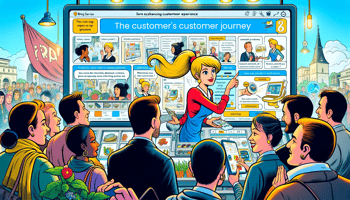Implementing a CPQ (Configure, Price, Quote) system can transform your sales processes and boost...
Why Business Intelligence Is Your Secret Weapon for Better Pricing After CPQ Go-Live
Many companies believe that the big win with CPQ happens at go-live. They imagine that once the system is launched, quoting will become faster, pricing will stabilize, and salespeople will simply sell more. That’s true — partly. But the real long-term advantage of CPQ doesn’t happen at go-live.
It happens after.
And it’s powered by Business Intelligence (BI).
At cpq.se, we help our customers understand that CPQ is not the final destination — it’s the beginning of a smarter, more data-driven way to run sales, pricing, and margin management. BI is the secret weapon that transforms your CPQ investment from a sales efficiency tool into a competitive advantage.
Why CPQ is Just the Starting Line
CPQ systems like Tacton CPQ are excellent at enabling complex product configuration, generating accurate pricing, and speeding up the quote-to-order process. But if you stop there, you’re missing the real potential.
Every quote, every discount decision, every configuration choice that passes through your CPQ system generates valuable data. Data about customer behavior. Data about pricing sensitivity. Data about product profitability.
The companies that win the long game don’t just automate quoting.
They learn from it.
What Business Intelligence Reveals
Before CPQ, companies often struggle to analyze pricing in any systematic way. Pricing data is hidden in emails, spreadsheets, and disconnected systems. After CPQ, for the first time, you have structured, clean, consistent transaction data at your fingertips.
When we integrate BI into your CPQ project, here’s what you can start analyzing:
-
Hit Rates: Which quotes convert into orders — and at what price points?
-
Discount Patterns: Which regions, sales teams, or product categories apply the most discounts?
-
Customer Segmentation: Which customers demand more discounting, and which accept value-based pricing?
-
Margin Realization: Where is margin leaking between quoted and invoiced prices?
With proper BI tools layered onto CPQ, you can move from vague discussions to hard facts: "In segment A, our average realized margin is 4% higher than in segment B."
This kind of visibility transforms pricing from an art into a science.
Building Pricing Improvements Over Time
At cpq.se, we don’t believe in the fantasy of "perfect pricing" at CPQ go-live.
Instead, we build projects around the idea of continuous improvement.
Here’s how we typically guide our customers:
-
Phase 1 (Go-Live): Get a functional, realistic pricing model into CPQ. Don’t aim for perfection — aim for visibility.
-
Phase 2 (First Insights): Start collecting BI data. Analyze what the transaction patterns are telling you.
-
Phase 3 (Targeted Adjustments): Use the data to refine segmentation, discount rules, and list pricing, focusing on the most impactful improvements.
-
Phase 4 (Mature Pricing Strategy): Gradually move toward value-based pricing, improved margin control, and better customer-specific strategies — all backed by hard data.
This method reduces risk, keeps your sales operations moving, and steadily builds pricing power.
Swift Lifts, for example, didn't wait for perfect pricing to implement CPQ. Instead, they embraced early BI insights to identify where certain product combinations were undervalued — and adjusted intelligently without slowing down quoting. That’s smart CPQ combined with smart BI.
The Danger of Ignoring Post-Go-Live Learning
Some companies think that once CPQ is live, the work is over. That’s a mistake.
Without active BI analysis:
-
Pricing models freeze and grow stale.
-
Discounting habits revert to old patterns.
-
Margin leakage quietly increases.
By contrast, companies that engage actively with their CPQ data can:
-
Spot underperforming segments early.
-
Proactively adjust to market shifts.
-
Optimize margins without alienating customers.
Data isn’t optional anymore. It’s the foundation for competitive, profitable pricing.
CPQ + BI: The Smart Manufacturer’s Strategy
When we design CPQ projects at cpq.se, we design them with BI in mind from day one. We don't just ask how fast you want to generate quotes — we ask what you want to learn from every quote generated.
By setting up a BI structure that captures configuration choices, discount levels, approval workflows, and final deal outcomes, you create a self-improving system.
-
Each transaction is a lesson.
-
Each quote is a data point.
-
Each closed deal improves the next pricing decision.
And over time, small improvements compound into major competitive advantages.
Don’t Wait for Perfect — Build for Smarter
The companies that hesitate, hoping to get their pricing "perfect" before launching CPQ, fall further behind.
The companies that move forward, launch, gather insights, and refine their pricing over time — they are the ones who turn CPQ into a real growth engine.
At cpq.se, we help you do both:
-
Short-term: Launch CPQ effectively, even with imperfect pricing.
-
Long-term: Leverage BI to evolve your pricing intelligently and continuously.
You don’t have to know everything now.
You just have to be ready to learn — and build a system that helps you do it better every quarter.
👉 Further Reading: How to Build Business Value with CPQ and BI
☕ Want to see how CPQ and Business Intelligence can sharpen your pricing over time?
Book a virtual coffee with Magnus Fasth or Patrik Skjelfoss: https://www.cpq.se/meetcpqse




